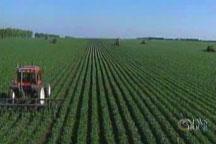China on the move: "Wilderness" yields grain today
2009-09-06 12:58 BJTSpecial Report: 60th Anniversary of PRC |
Watch Video

 Play Video
Play Video
In today's episode of the China on the Move series, our reporter Liu Ying takes us to Beidahuang, or the Great Northern Wilderness. It's located on the vast plains of China's northeastern province of Heilongjiang.
The more than 5 million hectares of fertile land was a wilderness more than half a century ago. But today it's China's largest base for grain production, producing more than 10 billion kilograms every year.
More than 600 kilometers to the north of the provincial capital Harbin, we arrived at the number 290 farm. It is one of the more than 100 farms of Beidahuang - China's big grain barn.
The autumn harvest is about two months away. Vast green fields spread out on both sides of the road. It looks like a bumper harvest this year.
But more than half a century ago, this was a completely different scene. Beidahuang was a desolate and uninhabited wasteland. Since the mid 1950s, hundreds of thousands of demobilized soldiers, college students and urban educated youth came to the place in response to the country's call to open up the wilderness.
Over the next twenty years, they staged the most spectacular land reclamation in the Chinese history.
Yang Keqiang was one of the pioneers. The Korean War veteran was dispatched to Beidahuang in 1955. Yang and his fellow soldiers built up more than 100 farms from nothing over the next two decades, turning wilderness into fertile land.
He settled down in Beidahuang and has never left. The 81-year-old says today's Beidahuang is beyond his imagination. He recalls his experiences here in early times.
Yang Keqiang, pioneers of Beidahuang, said, "At that time we thought about nothing but opening up wilderness. Our goal was to cultivate the land, build houses here and develop Beidahuang into a better place. We didn't feel the hardship at all. I think the spirit of Beidahuang is that you must not be afraid of hardship. You just do it."

 Mail
Mail Share
Share Print
Print


 Video
Video









 2009 China Central Television. All Rights Reserved
2009 China Central Television. All Rights Reserved